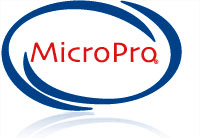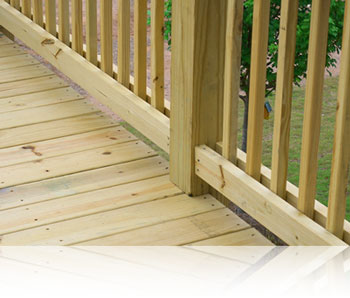
MicroPro® is the newest technology offering from Osmose for pressure treated wood. MicroCA™ pressure treated wood is treated with micronized copper preservatives, which help protect against termite damage and fungal decay. The Osmose MicroPro technology is the first treated wood process to be certified under Scientific Certification Systems Environmentally Preferable Product (EPP) program based on Life-Cycle Assessment. MicroCA offers many benefits including significantly improved corrosion performance. MicroCA treated wood products are U.S. building code compliant.

MicroCA brand treated wood products, available in Chile, use the MicroPro® technology. MicroCA pressure treated wood is treated with micronized copper preservatives, which help protect against termite damage and fungal decay. MicroPro technology is a revolutionary way to pressure treat wood for decks, fences, landscaping, and general construction uses, plus MicroPro technology offers many benefits, including significantly improved corrosion performance. MicroCA pressure treated wood with the MicroPro technology exhibits corrosion rates on metal products similar to CCA pressure treated wood and untreated wood.
SCS Certified
Environmentally Preferable Product (EPP) First Wood Treatment Process to Complete Life-Cycle Assessment Studies - The Osmose MicroPro wood treatment process systems were analyzed by Scientific Certification Systems under an exhaustive environmental review process called Life-Cycle Assessment (LCA), in accordance with rigorous international standards set by ISO, the leading international standards setting organization. The MicroPro LCA studies are in compliance with ISO standards 14044 and 14025.
NAHB Green Approved
The Osmose MicroPro technology has been approved for points toward National Green Building Certification to the ICC 700-2008 National Green Building Standard.
GREENGUARD® Certified
The Osmose MicroPro technology has been awarded the GREENGUARD Children & Schools Certification. GREENGUARD® Children & Schoolssm Certification program certifies products for low volatile organic chemical (VOC) emissions that are used in schools, offices and other sensitive environments.
GREENGUARD® is a registered trademark of GREENGUARD Environmental Institute.
Osmose MicroShades is a unique pigmented colorant system that can be used as an œin-solution system specifically developed for wood treated with the MicroPro preservative. Osmose water repellent additives are also available with the new MicroPro copper system.

MicroCA treated wood products are also available in popular consumer colors similar to redwood and cedar products with the new MicroShades® color pigment system. Osmose MicroShades is a pigmented colorant system that can be used as an œin-solution system specifically developed for wood treated with the MicroPro preservative. Osmose water repellent additives are also available with the new MicroPro copper system.
* Colors shown are are a representation only and may differ from actual product samples tested.
MicroCA treated lumber and other products can be used for interior and exterior uses. Exterior uses include above ground, ground contact, and fresh water contact.
| End Use Classifications for MicroPro/Smart Sense Pressure Treated Wood Products |
| General Use - Above Ground Examples - decking, joists, beams, and sills |
| Ground Contact and Fresh Water Contact Examples - decks, fence posts, playsets and docks |
| Ground Contact - Critical Structural Members Examples - building poles, permanent wood foundations |
MicroPro® technology offers many benefits including significantly improved corrosion performance. MicroCA pressure treated lumber and other wood products, with MicroPro® technology exhibits corrosion rates on metal products similar to CCA pressure treated wood and untreated wood.

For interior or exterior applications use fasteners and hardware that are in compliance with the manufacturers recommendations and the building codes for their intended use.
Aluminum building products may be placed in direct contact with MicroCA® treated lumber and other wood products used for interior uses and above ground exterior applications such as decks, fencing, and landscaping projects. Examples of aluminum products include siding, roofing, gutters, door and window trim, flashing, nails, fasteners and other hardware connectors. However, MicroCA treated lumber and other wood products in direct contact with aluminum products should only be used in code compliant construction applications that provide proper water drainage and do not allow the wood to be exposed to standing water or water immersion. In addition, MicroCA treated wood should not be encased, sealed, or wrapped with aluminum products where trapped moisture or water can occur so as to avoid pitting or other unwanted results.
We recommend you contact the aluminum building product manufacturer for their recommendations regarding their aluminum products in contact with MicroCA treated wood used in ground contact applications or when MicroCA treated wood is exposed to salt water, brackish water, and chlorinated water, such as swimming pools or hot tubs. Also, check with the aluminum product manufacturers regarding compatibility with other chemicals and cleaning agents. Contact Osmose for further information on aluminum contact use in commercial, industrial, and specialty applications such as boat construction
For more information download the Osmose Fastener & Hardware Information Sheet.
Apply a weather-resistant finish
Drill pilot holes
Deck board spacing
When appearance permits, attach boards bark side up As a general rule, attach boards bark side up (annual rings arc upward) to reduce cupping; however, the best face should be placed up when a defect of the wood is apparent. Fasten thin boards to thicker boards to maintain structural integrity.
|
|
Q1. What is MicroPro®/ MicroCA pressure treated lumber?
The MicroPro® lumber preservative is a waterborne, micronized copper azole preservative system developed to provide protection of wood exposed in interior or exterior applications.
Q2. What are the end use applications for MicroCA treated wood products?
MicroCA treated lumber and other wood products are available for: Above Ground, Ground Contact and Fresh Water Contact. MicroCA products are not currently approved for saltwater immersion applications.
Q3. What are retentions or retention levels?
Retention levels refer to the amount of preservative retained in the wood following the treatment process. Retention levels can be different based on the wood preservative system used to pressure treat the wood product and its intended end use (ground contact, above ground contact, etc.). It is important to purchase treated wood products for the intended exposure condition. Typically, wood products are treated for œabove ground use and œground contact/fresh water immersion use.
Q4. Is maintenance required on pressure treated wood projects?
Wood is a natural product, and whether wood is treated or untreated, it is not œmaintenance-free. Pressure treatment helps protect wood from fungal decay and termite attack. However, moisture, sun, and outdoor conditions may cause the wood project to show signs of weathering. Natural weathering such as raised grain, splitting, checking, twisting, warping, shrinkage, or swelling occurs in wood treated or untreated.
To help reduce the effects of natural weathering, the use of a clear water repellent coating or a semi-transparent water repellent coating product is recommended. If you desire to apply paint, stain, clear water repellent, or other finish to your preservative treated wood, we recommend following the manufacturers instructions and label of the finishing product. Before you start, we recommend you apply the finishing product to a small exposed test area before completing the entire project to insure it provides the intended result before proceeding.
Q5. Can I paint treated wood?
Yes. If you desire to apply paint, stain, clear water repellent, or other finish to your preservative treated wood, we recommend following the manufacturers instructions and label of the finishing product. Before you start, we recommend you apply the finishing product to a small exposed test area before completing the entire project to insure it provides the intended result before proceeding.
Q6. How often do I have to apply a finish to treated wood?
Most water repellent coating manufacturers recommend an annual application. We recommend you follow the manufacturers instructions.
Q7. My deck has not kept its original pressure treated wood color. How can I restore the appearance of the treated wood?
There are several pressure treated wood deck cleaning products on the market that are available and can be purchased from hardware stores or home centers. These cleaning products are typically referred to as cleaners, brighteners and restorers. Always follow the manufacturers recommendations.
Q8. Can I use a pressure washer on pressure treated wood?
Yes, follow the pressure washer manufacturers recommendations.
Q9. What fasteners or hardware should I use with treated wood?
MicroPro technology offers many benefits including significantly improved corrosion performance. Wood treated with MicroPro technology exhibits corrosion rates on metal products similar to CCA pressure treated wood and untreated wood.
For interior or exterior applications, use fasteners and hardware that are in compliance with the manufacturers recommendations and the building codes for their intended use. As with any good design and construction practices, MicroCA treated wood should not be used in applications where trapped moisture or water can occur. Where design and/or actual conditions allow for constant, repetitive or long periods of wet conditions, only stainless steel fasteners should be used.
For exterior applications: The following minimum galvanization levels may be used for connectors, joist hangers, fasteners and other hardware that are placed in direct contact with exterior applications of treated wood which utilizes MicroPro technology:
Fasteners - nails, screws, etc. ASTM “ A 153 (1 oz/ft2)
Hardware - connectors, joist hangers, etc. ASTM “ A 653 G90 (0.90 oz/ft2)
The effects of other building materials within a given assembly, along with environmental factors, should also be considered when selecting the appropriate hardware and fasteners to use for a given project containing treated wood.
Stainless Steel fasteners and hardware are required for Permanent Wood Foundations below grade and are recommended for use with treated wood in other severe exterior applications such as swimming pools, salt water exposure, etc. - Type 304 and 316 are recommended grades to use.
Q10. Can pressure treated wood posts be buried or installed in concrete?
MicroCA pressure treated wood posts produced for œground contact uses can be placed in the ground with or without the use of concrete.
Q11. Can treated wood be used in contact with manure or compost?
We do not recommend it; however, if MicroCA treated wood products are used for this application, it is suggested that all of the treated wood products are produced for œground contact use.
Q12. Can I use treated wood in my raised vegetable bed or around my grape vines?
MicroCA treated wood products may be used to construct raised bed gardens. The MicroPro treated wood process is certified by Scientific Certification Systems, Inc. (SCS) as an Environmentally Preferable Product (EPP) based on SCS™ Life-Cycle Assessment.
Recommended preservative retentions for MicroCA treated wood products: For MicroCA treated wood, the minimum preservative retention is 0.15 pcf.
Very small amounts of copper and azole will migrate out of MicroCA treated wood over time. If it is desirable to minimize the migration of copper and azole into the soil of a raised bed garden, we recommend that a suitable thin plastic material be used as a barrier between the MicroCA treated wood and the raised bed garden soil.
The use of a plastic barrier will also help keep the raised bed garden soil within the bed area. For proper drainage, the plastic material should not be used underneath the raised bed garden soil.
Q13. Is it safe to use treated wood in a picnic table or on countertops?
MicroCA pressure treated wood products can be used for outdoor picnic tables. We recommend that the picnic table be covered to prevent food from contacting the wood surface. It is not recommended that any treated wood product be used as a countertop. Do not put food directly in contact with treated wood.
Q14. Can I use treated wood in feed troughs for livestock?
Do not use preserved wood under circumstances where the preservative may become a component of food, animal feed, or beehives.
Q15. How does mold affect wood?
Mold occurring on pressure treated wood products is typically not an indication of fungal decay attack. Mold growth can and does occur on the surface of many products, including untreated and treated wood, during prolonged surface exposure to excessive moisture conditions. To remove mold from the treated wood surface, wood should be allowed to dry. Typically, mild soap and water can be used to remove remaining surface mold.